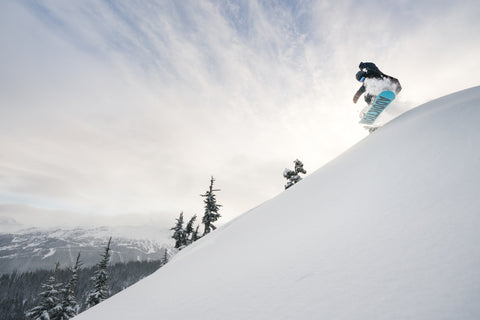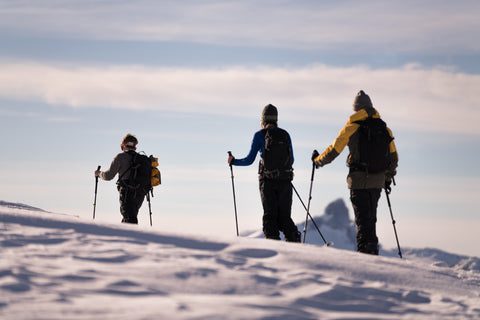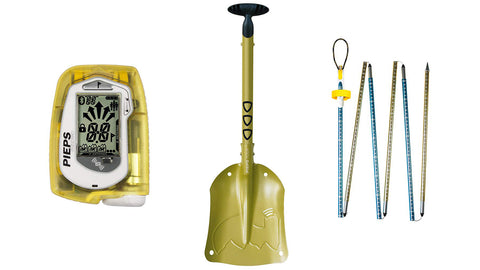
Backcountry Safety
Thinking about venturing off the beaten path and into the backcountry? We put together a short introduction to why you might want to get out there, ways of getting out there, and some safety tips for when you're out there.
Not ready for backcountry yet? Check out our How To Ride Powder tutorial.
(Narating/Riding: Nev Lapwood, Filmer: Vince Emond, Filmed at: Whistler Blackcomb)
Why ride the Backcountry?
The backcountry is filled with fresh untouched snow and sick conditions for first tracks - no wonder everybody loves riding powder. It is perfect for building jumps and trying new tricks. The landings in powder are more difficult than landings in the park, but they are softer and more forgiving, so you can try new tricks.
 Pow Laps!!!
Pow Laps!!!
Backcountry Safety
Backcountry is extremely fun, but it has many risks, such as variable weather and snow conditions, trees and tree wells, unmarked cliffs and avalanches.
 An avalanche debris path
An avalanche debris path
Most North American resorts are patrolled really well within the boundaries of the ski area. There are signs on the boarders of the ski area marking the limits of the patrolled and controlled resort. Within these boundaries of the resort they try to do everything they can to remove danger by bombing away avalanches and putting up warning signs. However, this does not mean that all areas within the resort are safe.
The equipment recommended in the video above is not only for riding out of bounds, but also for riding inside the resort in powder and advanced terrain.
How To Go Into The Backcountry
There are different ways to go backcountry and reach fresh powder: resort lifts, hiking/splitboarding, snowmobile, cat and heli.
The most common way is to take the lifts in the resort and ride between slopes or by hiking to catch fresh snow. Hiking can be difficult because most of the times you are walking uphill in deep untouched snow. It can be done easier with snowshoes - when riding down snowshoes are easy to attach to your backpack. You can also go hiking with a splitboard, essentially a snowboard that splits into skis that you can put traction skins on and walk uphill.
Snowmobiles can get you to an insane amount of fresh powder with little or no hiking, and they are at the same time extremely fun to cruise on. Snowmobiles are increasingly becoming a popular way to access the backcountry in North America.
 Earning your turns.
Earning your turns.
The ultimate way to ride powder is by cat or heli, because you can get to the best spots without using the energy you need to rip your pow lines - but it costs a lot. If you ever get the money to go in a heli, then go without hesitation, it will be the time of your life.
Equipment
The worst case scenario and most dangerous aspect of backcountry riding is getting caught in an avalanche. Make sure to know what you are going into, never travel alone and be prepared for self-rescue. Each member of your group should have:
- Backpack
- Shovel
- Probe
- Transceiver
- Knowledge of how to use your equipment
- Buddies because pow is better & safer with friends
The above are the essentials, food, water, layers, repair kit, rope, light, and first aid kit are some the other items that should be included in your pack depending on the duration of your trip.
 Backcountry safety kit; transceiver, shovel, probe
Backcountry safety kit; transceiver, shovel, probe
Transceivers, also known as beacons send out signals, so it is possible to search for and find people if they get caught in avalanches. They should by worn be each member if your group, with the harness they come and put on the 'send' setting. The transceivers also have a search function, so if you get buried in the snow your friends can switch their transceivers to this function and find you. Make sure to always have the transceivers fully charged and know how to use them. An avalanche course will teach you how to use the transceiver, so go get professional training before going into the backcountry.
Take a course and keep yourself up to date with new courses and train often with your buddies.

Squad life
Practice
For practice, bury a 'sending transceiver' in the snow as if you were caught in an avalanche and get your friends to try and find it. All your friends will then switch their transceivers to 'search' to find yours. Transceivers get you close fast, but you will need your probe to actually find someone. Probes are like sectional tent poles that snap together and are used to pinpoint someone in the snow so you don't waste any time. When you have located the person, you get your shovel and dig them out. A good shovel is light and strong - plastic is not good, it can break in cold temperatures. Once buried in the snow the best chances of survival are within the first 15 minutes, so know what is needed and do it fast.
Awareness
An avalanche course will teach you how to use your equipment. What's more important, courses teach you what signs to look, how to determine the danger level and what conditions and terrain to look for.
6 Things to look out for:
- Signs of avalanche activity within the last 48 hours
- Significantly loading from snow, wind or rain and changing snow conditions from temperature change (for example sun effected snow) within the last 48 hours
- Are you in an obvious avalanche path or entry zone
- Trees, cliffs and other obstacles that might increase danger
- Signs of unstable snow, like cracking and hollow sounds
Get as much information and avalanche reports from local area as you can.
Thanks for your attention. Please share the knowledge about backcountry safety with your friends before it is to late.
*This text and video is not sufficient knowledge to go and ride the backcountry. It is an introduction into safety, things to be aware of and required equipment. We highly recommend you and your friends to gain as much knowledge as you can and continuously take backcountry safety and avalanche courses.
Want more snowboard tip and tricks?
Snowboard Addiction
Our Goal Is To Improve Your Riding

 Pow Laps!!!
Pow Laps!!! An avalanche debris path
An avalanche debris path Earning your turns.
Earning your turns. Backcountry safety kit; transceiver, shovel, probe
Backcountry safety kit; transceiver, shovel, probe